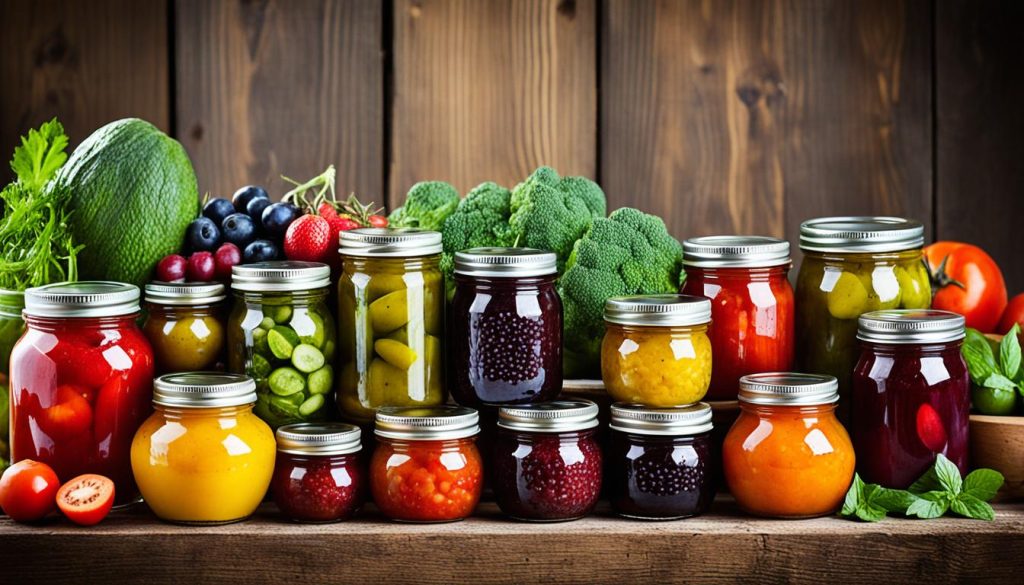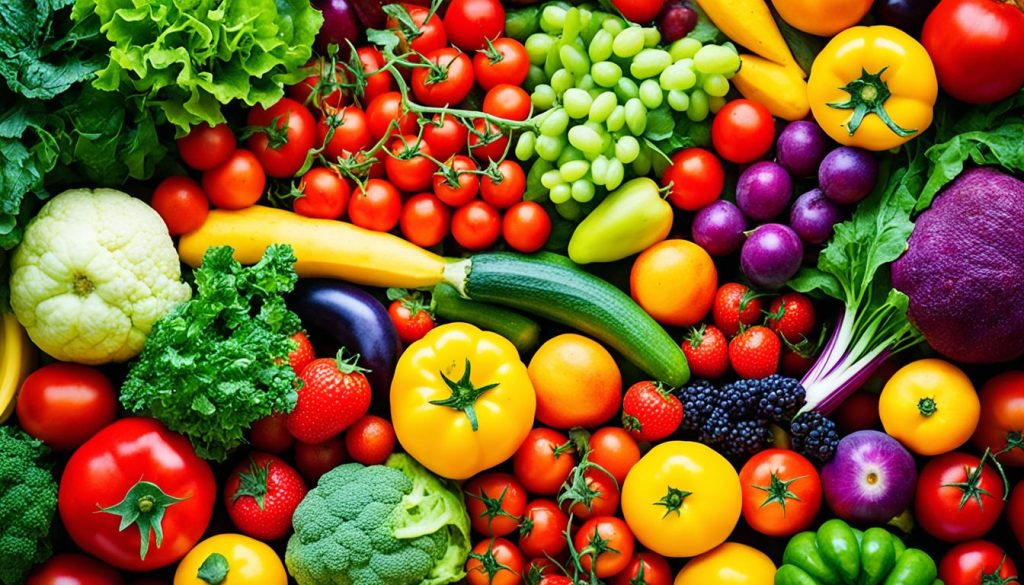Did you know that home canning and preserving is a centuries-old tradition that is regaining popularity in recent years? In fact, a staggering 60% of American households participate in some form of home canning or preserving to enjoy their own homemade delights. Whether it be jams, pickles, or canned fruits and vegetables, people are discovering the joy of preserving their favorite foods and savoring the flavors all year round.
The Importance of Safe Canning and Preserving
Home canning is a safe and rewarding method of food preservation that allows individuals to enjoy the flavors of homemade delights while ensuring the quality and safety of preserved foods. When practiced properly, home canning helps destroy microorganisms that could be a health hazard or cause the food to spoil, making it an effective way to extend the shelf life of fresh produce.
One of the key reasons for emphasizing safe canning and preserving techniques is to prevent food-borne illnesses, such as botulism, which can be associated with improperly canned foods. Botulism is a potentially life-threatening form of food poisoning caused by the Clostridium botulinum bacteria, which thrives in low-oxygen environments like those created in improperly canned foods. It is important to follow safety standards and guidelines to minimize the risk of botulism and other food-related illnesses.
Adhering to safety standards includes practicing proper sterilization techniques, maintaining appropriate acidity levels, and ensuring the correct processing times and temperatures. These measures help create an environment that is inhospitable to microorganisms and inhibit their growth, reducing the risk of food spoilage and bacterial contamination.
It is crucial to highlight that the safety and quality of preserved foods heavily rely on the proper execution of canning and preserving techniques. Cutting corners or deviating from recommended practices can compromise the safety of the final product, putting consumers at risk of foodborne illnesses. It is essential to prioritize food safety and follow established guidelines to preserve the integrity of homemade delights.
To further illustrate the significance of safe canning practices, the potential consequences of improperly canned foods must be emphasized. Consuming foods contaminated with the Clostridium botulinum bacteria can lead to botulism poisoning, which affects the nervous system and can cause symptoms such as weakness, dizziness, difficulty swallowing, blurred vision, and even paralysis. These symptoms can be severe and life-threatening, highlighting the importance of proper canning techniques.
Safe canning and preserving techniques not only prevent food-borne illnesses but also help maintain the flavor, texture, and nutritional value of preserved foods. By following recommended practices, home canners can confidently enjoy their homemade preserved fruits, vegetables, jams, jellies, and pickles without worrying about the risks associated with improperly canned foods.
The Dangers of Botulism
Botulism is a rare but serious illness caused by the Clostridium botulinum bacterium. This bacterium produces a powerful neurotoxin that affects the nervous system, leading to symptoms such as muscle weakness, double vision, difficulty swallowing, and even paralysis. In severe cases, it can be life-threatening. Home canning and preserving must be approached with caution to avoid the risks of botulism and other food-borne illnesses.
| Disease | Food Commonly Associated With |
|---|---|
| Botulism | Improperly canned, low-acid foods; home-canned vegetables and meats |
| Salmonella | Poultry, eggs, unpasteurized milk, raw fruits and vegetables, contaminated water |
| E. Coli | Undercooked ground beef, contaminated produce, unpasteurized apple cider, raw dairy products |
Different Methods of Canning and Preserving
When it comes to canning and preserving food, there are different methods to consider based on the type of food you want to preserve. Each method has its own set of requirements and benefits. Let’s explore some of the most common methods:
1. Water Bath Canning
Water bath canning is a method specifically designed for preserving high-acid foods such as fruits, tomatoes, and pickles. This method involves submerging the filled jars in boiling water for a specified amount of time. The high heat kills any potential bacteria and creates a seal that prevents spoilage. It is a simple and accessible method for beginners.
2. Atmospheric Steam Canner Method
The atmospheric steam canner method is suitable for naturally acidic or properly acidified foods like fruits, preserves, and some pickled vegetables. It uses steam to create the necessary heat for canning. This method is efficient and requires less water compared to water bath canning.
3. Pressure Canning
Pressure canning is the only safe method for preserving low-acid foods such as vegetables, meats, poultry, and seafood. These foods have a higher risk of bacterial growth and require higher temperatures to ensure safety. Pressure canning uses a specialized pressure canner that reaches temperatures above the boiling point, effectively killing any harmful microorganisms and sealing the jars.
Here is a table summarizing the advantages and considerations of each method:
| Method | Advantages | Considerations |
|---|---|---|
| Water Bath Canning | – Suitable for high-acid foods – Easy and accessible for beginners – Requires basic equipment |
– Not suitable for low-acid foods – Longer processing times for larger jars |
| Atmospheric Steam Canner Method | – Efficient use of water – Suitable for naturally acidic or properly acidified foods – Quick processing times |
– Limited suitability for non-acidic foods – Requires specific equipment |
| Pressure Canning | – Safe for low-acid foods – Can reach higher temperatures – Allows for longer shelf life |
– Requires a pressure canner – More complex process – Longer processing times |
Each method requires specific equipment and processing techniques, so it’s essential to choose the method that aligns with the type of food you want to preserve. Remember to always follow proper guidelines and recipes to ensure the safety and quality of your preserved foods.
Choosing the Right Recipe for Canning
When it comes to canning, selecting the right recipe is essential to ensure successful preservation. Recipes specifically developed for the canning method you plan to use are important to guarantee the safety and quality of your preserved foods.
It is recommended to source your canning recipes from research-based sources such as the USDA, the National Center for Home Food Preservation, and extension resources. These sources provide reliable information and have extensively studied the best practices for canning and preservation.
When evaluating a recipe, pay attention to the instructions regarding ingredients, preparation, and processing times. This is particularly crucial for recipes involving acidic and properly acidified foods. The acidity level plays a vital role in ensuring the preservation of the food and preventing the growth of harmful bacteria.
Altitude adjustments might also be necessary when following canning recipes. Most recipes are designed for altitudes between 0-1,000 feet. If you live at a higher altitude, it’s important to make the necessary adjustments to ensure proper processing and prevent potential issues.
| Key Tips for Choosing the Right Canning Recipe |
|---|
| Source recipes from research-based sources |
| Pay attention to acidity levels in recipe instructions |
| Consider altitude adjustments for your location |
Example Canning Recipe Sources
- USDA’s Complete Guide to Home Canning
- National Center for Home Food Preservation
- Extension resources from reputable institutions
By selecting the right recipe and following trusted sources, you can ensure that your canning endeavors result in safe and delicious preserved foods.
Preparation and Packing for Canning
Proper preparation and packing are crucial for successful canning. To ensure the best quality of preserved foods, it is essential to start with fresh produce and thoroughly wash it to remove any dirt or contaminants. This step helps maintain the flavor and nutritional value of the fruits and vegetables being preserved.
In addition to fresh produce, it is important to pay attention to the sterilization of the canning jars. Before filling the jars, they should be carefully examined and any dirt or debris should be removed. Jars and lids can also be sterilized by boiling them in water for a few minutes or by using hot water from the tap.
When it comes to the methods of pack, there are two common techniques: raw pack and hot pack. The choice of method depends on the type of food being preserved. Raw pack involves filling the jars with uncooked raw food, while hot pack requires precooking the food before packing it into the jars. The hot pack method is often preferred for certain vegetables and meats as it helps improve the texture and taste of the preserved product.
One important consideration during the packing process is to leave adequate headspace in the jars. This refers to the empty space between the top of the food and the rim of the jar. The headspace allows for proper expansion of the food during the canning process and helps prevent the jar from breaking. The specific headspace requirement may vary depending on the recipe and type of food being preserved, so it’s important to follow the instructions provided in the recipe.
To summarize, successful canning starts with proper preparation, including washing fresh produce and sterilizing jars. Choosing the appropriate method of pack and leaving adequate headspace in the jars are key factors in ensuring the quality and safety of preserved foods.
For more information on home canning safety, refer to the CDC website.
The Canning Process
The canning process is a crucial step in preserving foods for long-term storage. Whether you are using the water bath canning method or a pressure canner, understanding the process is key to successful canning.
Water Bath Canning
Water bath canning is a popular method for preserving high-acid foods such as fruits, tomatoes, and pickles. It involves submerging filled jars into a boiling water bath for a specified processing time. The heat from boiling water destroys bacteria and enzymes, ensuring the safety and longevity of the preserved foods.
During water bath canning, it is important to maintain a rolling boil throughout the processing time. This consistent high temperature eliminates any potential bacteria or pathogens that could cause spoilage or foodborne illnesses. By following the recommended processing time for each specific food item, you ensure that harmful microorganisms are effectively destroyed.
Creating a Vacuum Seal
As the jars cool down after processing, a vacuum seal is created, further protecting the food inside. The cooling process causes the heat and oxygen to escape through the lids, resulting in a tight seal that prevents air and bacteria from entering the jars. This vacuum seal enhances the preservation of the food, allowing it to be stored safely for an extended period.
It is important to check the sealed jars after they have cooled to ensure that the lids are properly sealed. A vacuum-sealed lid should not flex or move when pressed with a finger. If a lid is not sealed correctly, the contents may spoil or become contaminated, so it is crucial to reprocess or refrigerate any jars that fail the seal test.
The combination of water bath canning and the vacuum seal is a reliable and effective method for preserving high-acid foods. It allows you to safely enjoy your favorite homemade jams, jellies, and pickles throughout the year.
Equipment and Supplies for Home Canning
To start home canning, it is important to have the necessary equipment and supplies. These canning supplies are essential for safe and effective preservation of your favorite fruits, vegetables, and other foods.
Canning Kettle:
A canning kettle is a large pot with a lid and a rack at the bottom. It is designed to hold and process multiple jars at once in a boiling water bath. A canning kettle is a versatile piece of equipment that is suitable for high-acid foods and can be used for water bath canning.
Pressure Canner:
A pressure canner is a specialized piece of equipment used for canning low-acid foods like vegetables, meats, poultry, and seafood. It uses high-pressure steam to safely preserve these foods. A pressure canner is an essential tool for home canning if you plan to preserve low-acid food items.
Jar Grabbers:
Jar grabbers, also known as jar lifters or jar tongs, are designed to safely remove hot jars from boiling water or a pressure canner. They have gripping ends that securely hold the jars, preventing any accidents or burns during the canning process.
Metal Funnel:
A metal funnel with a wide mouth is useful for filling jars with hot liquids, sauces, and other preserves. It helps prevent spills and ensures that the contents of the jar are neatly and safely poured into the containers.
Canning Jars, Lids, and Rings:
Canning jars are specifically designed for home canning. They are made of sturdy glass and come in various sizes to accommodate different food quantities. The lids and rings create a tight seal on the jars, preventing air and bacteria from entering. It is important to use new lids for each canning session to ensure a proper and secure seal.
Before filling the jars, make sure to wash and dry them thoroughly. This eliminates any potential contaminants and helps maintain cleanliness throughout the canning process. The lids should be softened in hot water to activate the sealing compound before use.
Having the right equipment and supplies ensures that you can safely and effectively preserve your favorite foods. Whether you’re using a canning kettle for water bath canning or a pressure canner for low-acid foods, investing in quality tools will make your home canning experience a success.
For more information on storing canning supplies, visit this resource.
| Equipment | Uses |
|---|---|
| Canning Kettle | Used for water bath canning of high-acid foods |
| Pressure Canner | Used for pressure canning low-acid foods |
| Jar Grabbers | Used to safely remove hot jars |
| Metal Funnel | Used for neat and spill-free jar filling |
| Canning Jars, Lids, and Rings | Essential containers and seals for preserving food |
Conclusion
Home canning is a fulfilling and enjoyable process that allows you to take charge of the quality and flavors of your preserved foods. By following safe canning techniques, selecting reliable recipes, and using proper equipment and supplies, you can confidently enjoy your homemade delights while ensuring food safety.
Preserving food at home not only gives you control over the freshness and ingredients but also allows you to savor the tastes and flavors throughout the year. With the right knowledge and precautions, you can maintain the quality and nutrition of your preserved foods for extended periods.
Remember, food safety is of utmost importance when it comes to home canning. Ensure proper sterilization, acidity testing, and accurate processing times to prevent any risk of contamination. By adhering to these practices, you can enjoy the pleasure of homemade delights while keeping your family safe.


